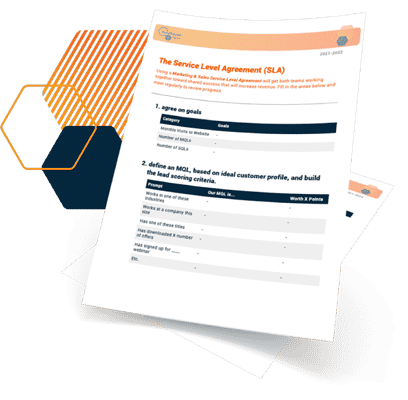
Sales and marketing departments are meant to work as a team but instead of the Justice League, companies often have a relationship that more closely resembles 2016’s cinematic disaster Batman v Superman.
In theory, each department works toward the growth of the business but due to different incentives, there is an inherent tension between the roles. Sales teams are typically focused on short-term, tangible goals while marketing will likely be focused on long-term, strategic goals.
For most organizations, the primary currency exchanged between sales and marketing is leads. These are the fruits of a marketing team’s labor, which sales then nurture into sweet, sweet wine or pies, or whatever fruit-based output you want to picture sales as.
One of the issues in this marketing-sales pipeline is while marketing produces leads, they’re often more concerned with the quantity of leads rather than the quality, or other performance metrics. If sales underperform, they may blame marketing and demand better leads. Of course, if the leads are underperforming, marketing teams can point to sales’ lack of execution.
This is a symptom of a well-documented problem in business organizations called silos. Silos are where different departments operate in isolation, with little cooperation, and marketing and sales may be the most famous of all silos.
Solutions to Marketing and Sales Silos
Silos have varying degrees of severity. Some marketing and sales teams may be in open competition for the overall budget, while others may just need a bit of relationship counseling.
The first step to any successful relationship is open communication. Feel free to use this in business or with your significant other. Open communication can be as simple as holding quarterly meetings to discuss goals and strategies. You might be surprised at how few companies actually do this.
Once overall goals and strategies are established, sales and marketing can begin the process of creating shared goals and working toward a common objective.
Qualifying Leads
At Hivehouse, rather than just reporting on the number of leads, we utilize marketing qualified leads (MQLs), to ensure that leads are vetted by marketing before being passed to sales.
In order for a lead to become an MQL, it has to fulfill certain criteria, such as specific customer information, like job title or industry, or web activity, such as downloading a particular piece of content.
Defining an MQL goes back to open communication between sales and marketing. The folks in sales need a certain amount of information about their leads to understand if they are worth devoting time and resources to. Essentially, is this lead a good fit for what your company is providing?
To create a shared understanding of what makes a great lead, companies should develop an ideal customer profile (ICP).
Building an Ideal Customer Profile
You can think of an Ideal Customer Profile, kind of like a dating profile—what are the green flags that indicate this lead will make a great customer? Rather than whether they’d like to have kids or not, ICPs consist of attributes such as:
- Industry – Which specific verticals are your services or products intended to be used in?
- Company Size + Budget – Does your company target mom-and-pop shops or Fortune 500 companies? What size budget should the company have?
- Role + Responsibilities – Who are your products or services intended to provide a solution for? Who are the decision-makers in those roles?
- Location – Is your product or service limited to a certain geographic location?
- Preferred Marketing Channels – How do your leads typically communicate with you?
An ICP can be as extensive and specific as necessary, and it’s likely your company may need more than one, depending on how many services and products you offer. ICPs are helpful beyond just qualifying leads. They help marketing teams align on who their output, such as content, is targeting. Don’t have an ICP documented somewhere? Download our Ideal Customer Profile Template to begin building yours.
Once you have an ICP outlined, you now have the necessary information to find out if any old lead should become a marketing-qualified lead.
The Marketing & Sales Service Level Agreement
Another tool we use at Hivehouse Digital to ensure that marketing and sales are working together is a Marketing & Sales Service Level Agreement.
The Marketing & Sales Service Level Agreement is a document where marketing and sales detail their shared goals, MQLs, and lead handoff workflows. We went into deep detail on how to set one up this blog post, but the five primary steps are:
- Identify and Document your Sales/Marketing Goals
What are your sales goals for the quarter? How many quality, a.k.a marketing qualified leads does your sales team need to reach those goals?
- Document a Clearly-defined MQL Based on Your ICP
Build your ICP, as seen above, and make sure an MQL follows those guidelines.
- Establish Quarterly MQL Goals
How many MQLs should your marketing team be working towards?
- Outline and Establish the Marketing to Sales Lead Hand-Off Process
We use HubSpot to set up lead scoring, so when a lead reaches a certain score based on pre-established criteria, sales will be notified.
- Establish the Sales Engagement Flow and Service Level Agreement
A lot of fingers get pointed at marketing when it comes to leads, this step will hold your sales team accountable and ensure they’re nurturing the MQLs appropriately.
All of this starts with regular communication. The Marketing and Sales Service Level Agreement provides the framework to move the conversation and relationship along, but without the two sides agreeing to meet, it’s all for naught. Think of the Marketing and Sales SLA as a conversation starter for each of the barriers that may be preventing your marketing and sales team from reaching their potential.
Ready to knock down silos and create a marketing and sales alliance that feels like the Avengers? Download our Marketing & Sales Service Level Agreement template, and let the team at Hivehouse Digital know if you need any help.
Get the latest news
Blog Topics
- Analytics
- Branding & Identity
- Budget
- Construction
- Content Marketing
- Conversion Rate Optimization
- Email Marketing
- HubSpot
- Inbound Marketing
- Lead Generation
- Marketing Strategy
- News/Events
- Paid Search & PPC
- Recruiting
- Sales & Marketing
- Sales Enablement
- Search Engine Marketing
- Search Engine Optimization
- Social Media
- Thought Leadership
- Uncategorized
- Usability
- Video Marketing
- Web Hosting
- Website Design
